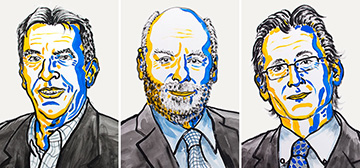
Left to right: 2016 Nobel chemistry laureates Jean-Pierre Sauvage, Sir J. Fraser Stoddart and Bernard L. Feringa. [Illustrations by N. Elmhed, © Nobel Media 2016]
The 2016 Nobel Prize in Chemistry has gone to Jean-Pierre Sauvage, Sir J. Fraser Stoddart and Bernard L. Feringa, for their pathbreaking work in “the design and synthesis of molecular machines.” The work of the three scientists opened up, and continues to mark out, new horizons for chemically synthesized machines only nanometers in scale—including molecular motors that increasingly feature light as the power source. Taken together, these molecular machines are now emerging as a key platform for applications in biomedicine, smart materials and more.
Basic (and complex) chemistry
The physicist Richard Feynman, in a widely cited 1959 talk, noted the prospect of building small machines out of atoms, and even raised the then-fanciful vision of an infinitesimal “molecular automobile.” But the design and building of such machines lies squarely in the domain of basic chemistry, and in the devilishly difficult problem of synthesizing compounds that have the right properties to serve as molecular machines. Those properties include molecular geometries and sufficiently supple chemical bonds to allow controlled translation and rotation, overcoming the thermal background noise of Brownian motion.
Two of the 2016 laureates were honored in particular for their work in overcoming those problems of basic chemistry. Sauvage (University of Strasbourg, France), in 1983, created new methods of “template synthesis” that used the coordination of metal ions to thread molecules together into “topologically entangled” ring structures (catanes and roxatanes). Those interlocked nanoscale structures featured flexible mechanical bonds, rather than rigid covalent bonds—and, like a pair of wings, could move freely with respect to one another, and support rotational motion.
Another key step in chemical synthesis of nanomachines came in 1991, when the team of the second laureate, Stoddart (Edinburgh University, U.K.), created methods to fashion molecules with so-called translational isomerism—molecules that could, by changing to a different form or isomer, move back and forth from station to station along a linear molecular “axle.”
Both the Sauvage and Stoddart groups were subsequently able to demonstrate that they could also control the motion of the molecules electrochemically, through oxidation-reduction reactions or pH changes. Since then, they’ve built increasingly complex assemblages, including molecular “muscles” and “elevators” in which the molecular “car” shuttles between “floors” separated by a mere 0.7 nm. Stoddart’s group in particular has also explored the prospect of using molecular-scale devices in computer memory and logic gates.
Toward (light-driven) molecular motors
The work of the third laureate, Feringa (University of Groningen, Netherlands), moves from the notion of molecular machines to actual molecular motors—the ability to move a molecular machine in one direction only, and far enough from equilibrium to do useful work. In that quest, Feringa, a photochemist, relied on light as the power source.
In the late 1990s, Feringa found that, by engineering specific asymmetries into alkene molecules, he could use cycles of UV light and heat to alternately stress and relax the molecule, and cause the molecule to rotate in a single direction in a highly controlled way. Over time, Feringa’s group built on that initial breakthrough to create motor structures that could rotate at frequencies as high as 12 MHz. The team has also fashioned nanomotors as diverse as light-driven molecular propellers and even—in the past few years—a version of the molecular automobile that Feynman had proposed half a century earlier.
A new machine age?
The work of the laureates has created new possibilities for using nanoscale motors, and light-driven motors in particular, in a wide variety of applications. “It’s still early days yet,” said Feringa, speaking by phone at the press announcement for the prize, “but one can think of all sorts of features” in which the machines could become important. In particular, Feringa noted the prospect of using molecular motors for transport of drugs within cells, for building micro-robots that can be “injected into the bloodstream to search for cancer,” and for creating “smart” materials that can “adapt with an external signal, just like our body functions.”
Olof Romström, a member of the Nobel Commission who talked in detail about the scientific accomplishments that led to the prize, drew a different analogy about the work and its importance: He compared it to the groundwork laid by 19th-century scientists to develop the theory and early applications of electromagnetism that have led to the electrical machines that are ubiquitous in modern life. “They created a revolution,” he noted—and, he suggested, the groundwork laid by the three laureates could presage a similar revolution in the coming century. “The future will show what kind of applications will come out of this.”
